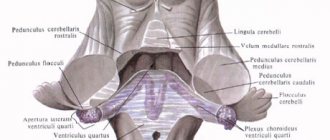Liquor is the cerebrospinal fluid that fills and washes the anatomical spaces of the brain and spinal cord. It carries the most important functions of protecting these organs from damage and shock, helps maintain the constancy of liquid media, and maintains intracranial pressure. In addition, it is involved in the release of brain metabolites and the transport of nutrients. Analysis of cerebrospinal fluid helps to identify pathologies of the central nervous system, their degree and development, since cerebrospinal fluid immediately reacts by changing parameters to any changes in the brain.
Indications for use
A study of cerebrospinal fluid is carried out when:
- the appearance of a risk of hemorrhage in the brain cavity;
- infections that affect the central nervous system and lead to inflammation of the membranes (meningitis, encephalitis, meningoencephalitis);
- malignant formations in the meninges;
- there is a suspicion of liquorrhea (loss of cerebrospinal fluid), the main cause of which is a violation of the integrity of the hard membranes of the brain.
The above indications are absolute, i.e. requiring mandatory analysis of the cerebrospinal fluid. The study can also be chosen as a diagnostic tool in other situations. Such relative indications may include:
- diseases caused by demyelination, i.e. destruction of the myelin sheath of neurons, in which the conductivity of nerve impulses deteriorates and various abnormalities occur (for example, multiple sclerosis);
- autoimmune diseases;
- blockage of blood vessels by pathogenic organisms (septic embolism);
- the child has a fever of unknown origin;
- systemic lesions of peripheral nerves (polyneuropathy) caused by inflammatory reactions.
In some cases, cerebrospinal fluid analysis is contraindicated, for example, in case of a large tumor, greatly increased cranial pressure, or edema.
The procedure is prescribed with caution in cases of bleeding disorders (due to the risk of bleeding) or thrombocytopenia (a decrease in the number of platelets, accompanied by bleeding).
Total protein in liquor
Measuring the concentration of total protein in the cerebrospinal fluid (cerebrospinal fluid), used for diagnosis and monitoring of treatment of infectious-inflammatory, oncological, autoimmune and other diseases of the central nervous system.
Synonyms Russian
Total protein in cerebrospinal fluid, CSF; analysis of cerebrospinal fluid for total protein; analysis of CSF for total protein.
English synonyms
Cerebrospinal fluid, Total Protein; Total Protein CSF.
Research method
Colorimetric photometric method.
Units
G/L (grams per liter).
What biomaterial can be used for research?
Liquor.
How to properly prepare for research?
No preparation required.
General information about the study
Liquor (cerebrospinal fluid) is the only biological medium, the study of which in clinical practice allows one to obtain accurate information about the state of the central nervous system. Many diseases of the brain and spinal cord are accompanied by changes in the normal composition of the cerebrospinal fluid. One of the components of the cerebrospinal fluid, the concentration of which changes in diseases of the central nervous system, is total protein. Measuring the concentration of total protein in the cerebrospinal fluid is a mandatory analysis, which is carried out if infectious-inflammatory, oncological, autoimmune and other diseases of the central nervous system are suspected.
Total protein in the cerebrospinal fluid is one of the most sensitive indicators of CNS pathology. Normally, the cerebrospinal fluid of an adult contains 150-500 mg/l of protein. The majority (80%) comes from the blood when it is filtered in the choroid plexus of the ventricles of the brain. A smaller portion is produced directly intrathecally (by choroid plexus cells, glia, neurons and immune cells). The protein composition of the cerebrospinal fluid is very dependent on the protein composition of the blood. As in blood, normally the main protein of the cerebrospinal fluid is albumin (it makes up 35-80% of the total protein of the cerebrospinal fluid), and the main immunoglobulins of the cerebrospinal fluid belong to class G immunoglobulins. It should be noted that normally the main part of IgG enters the cerebrospinal fluid from the blood , and is not synthesized intrathecally.
On the other hand, the protein composition of the cerebrospinal fluid is very different from the protein composition of the blood. This difference is due to the presence of the blood-brain barrier (BBB), a mechanical filter that prevents the entry of blood proteins into the cerebrospinal fluid. Small proteins (albumin) easily pass through the BBB, while the entry of large protein molecules (immunoglobulins) is difficult. Thus, the diffusion of albumin from the blood into the cerebrospinal fluid takes about 1 day, and the diffusion of IgM immunoglobulins takes several days. As a result, the total protein in the cerebrospinal fluid is only 0.1-0.2% of the amount of blood protein. In addition, CNS-specific proteins can be detected in the cerebrospinal fluid, for example, myelin basic protein, glial fibrillary acidic protein, and tau protein. These specific proteins, however, account for about 1-2% of the total cerebrospinal fluid protein.
Changes in the concentration of total protein in the cerebrospinal fluid are often observed in diseases of the central nervous system. An increase in the level of total protein in the cerebrospinal fluid can be observed in 3 situations: 1) An increase in the permeability of the BBB. This mechanism underlies changes in protein levels in the cerebrospinal fluid in most infectious and inflammatory diseases. In this case, changes in the protein composition of the cerebrospinal fluid reflect changes in the composition of the blood protein. 2) Enhanced protein synthesis intrathecally, as, for example, in multiple sclerosis, sarcoidosis or neurosyphilis. 3) Impaired resorption of cerebrospinal fluid protein through arachnoid granulations (processes in the pia mater).
An increase in the level of total protein in the cerebrospinal fluid is a characteristic sign of damage to the central nervous system. It is observed with bacterial (0.4-4.4 g/l), cryptococcal (0.3-3.1 g/l) and tuberculous (0.2-1.5 g/l) meningitis and neuroborreliosis. A total protein concentration of more than 1.5 g/l is a specific (99%) sign of bacterial meningitis. In viral neuroinfections (encephalitis, meningoencephalitis), the level of total protein is not so much increased (usually less than 0.95 g/l). In half of patients with herpetic encephalitis, the level of total protein in the cerebrospinal fluid remains normal. An increase in total protein levels can also be observed in subarachnoid hemorrhage, vasculitis with central nervous system involvement, and in the presence of malignant neoplasms of the central nervous system. An increase in the concentration of total protein with a normal number of cerebrospinal fluid cells (albumin-cell dissociation) is a characteristic sign of acute and chronic inflammatory demyelinating polyneuropathies. It should be noted that during the first week of diseases from this group, the total protein in the cerebrospinal fluid can remain within normal limits. It is elevated in 80% of patients with metastatic lesions of the pia mater (average concentration is about 1 g/l). A moderate increase in total protein in the cerebrospinal fluid can also be observed in a variety of peripheral neuropathies, such as diabetic neuropathy.
A decrease in the level of total protein in the cerebrospinal fluid can be observed with repeated lumbar punctures or with chronic cerebrospinal fluid leaks - conditions in which cerebrospinal fluid is lost faster than it is produced. Also, lower levels of total protein are detected in some children aged 6 months - 2 years, with water intoxication and in some cases of idiopathic intracranial hypertension.
The level of total protein in the cerebrospinal fluid depends on many factors. Thus, the concentration of total protein in the liquor of infants is much higher than that of an adult. “Adult” levels of total protein are established at approximately 6-12 months. A false increase in the concentration of total protein in the cerebrospinal fluid can be obtained during a traumatic lumbar puncture, when a large number of red blood cells are present in the blood sample.
Reference values for total protein vary between laboratories due to different methods for determining it. Therefore, if repeated (multiple) tests of cerebrospinal fluid for total protein are planned, for example, to monitor the treatment of a disease, it is recommended that all tests be performed in one laboratory.
Due to the fact that the amount and composition of protein in the cerebrospinal fluid strongly depends on the amount and composition of protein in the blood, a test for protein in the cerebrospinal fluid should always be supplemented with a test for protein in the blood.
What is the research used for?
- For diagnosis and control of treatment of infectious-inflammatory, oncological, autoimmune and other diseases of the central nervous system.
When is the study scheduled?
- If you suspect the presence of infectious-inflammatory, oncological, autoimmune and other diseases of the central nervous system;
- during a follow-up examination of a patient undergoing treatment for any of these diseases.
What do the results mean?
Reference values
| Age | Reference values |
| 0-16 years | 0.15 - 1.3 g/l |
| More than 16 years | 0.15 - 0.45 g/l |
Reasons for the increase:
- Brain abscess;
- Malignant brain tumor;
- Spinal cord tumor;
- Diabetic neuropathy;
- Guillain–Barré syndrome;
- Freun's syndrome;
- Heavy metal poisoning;
- Traumatic brain injury;
- Hemorrhage (intracerebral, subarachnoid);
- Bacterial meningitis;
- Viral meningitis;
- Tuberculous meningitis;
- Cryptococcal meningitis;
- Multiple sclerosis;
- Myxedema;
- Sarcoidosis;
- Neurosyphilis;
- Systemic lupus erythematosus;
- Thrombosis of cerebral vessels;
- Alcohol consumption;
- Rupture of intracerebral aneurysm;
- Use of isopropanol and phenytoin
Reasons for the downgrade:
- Successful treatment of the disease;
- Water intoxication;
- Multiple lumbar punctures;
- Chronic liquorrhea;
- Some cases of idiopathic intracranial hypertension;
- Age 6 months – 2 years
What can influence the result?
- Age;
- Presence of erythrocytes in the cerebrospinal fluid sample;
- Taking certain medications (phenytoin) and alcohol
Important Notes
- A test for protein in the cerebrospinal fluid should always be supplemented with a test for protein in the blood;
- It is recommended that all tests for total protein in cerebrospinal fluid be performed in one laboratory.
Also recommended
- Glucose in cerebrospinal fluid
- Diagnosis of multiple sclerosis (isoelectric focusing of oligoclonal IgG in cerebrospinal fluid and serum)
- Myelin basic protein in cerebrospinal fluid (CSF)
- Herpes Simplex Virus 1/2, DNA [real-time PCR]
- Treponema pallidum, IgG in cerebrospinal fluid
- Toxoplasma gondii, DNA [real-time PCR]
- Cytomegalovirus, DNA [real-time PCR]
- Borrelia burgdorferi sl, DNA [PCR]
Who orders the study?
Neurologist, neurosurgeon, general practitioner.
Literature
- Dean A. Seehusen, Mark M. Reeves, Demitri A. Fomin. Cerebrospinal Fluid Analysis. Am Fam Physician. 2003 Sep 15;68(6):1103-1109.
- Walker HK, Hall WD, Hurst JW. Clinical Methods: The History, Physical, and Laboratory Examinations. 3rd edition. Boston: Butterworths; 1990.
- Hühmer AF, Biringer RG, Amato H, Fonteh AN, Harrington MG. Protein analysis in human cerebrospinal fluid: Physiological aspects, current progress and future challenges. Dis Markers. 2006;22(1-2):3-26.
- Deisenhammer F, Bartos A, Egg R, Gilhus NE, Giovannoni G, Rauer S, Sellebjerg F; EFNS Task Force.
- Guidelines on routine cerebrospinal fluid analysis. Report from an EFNS task force. Eur J Neurol. 2006 Sep;13(9):913-22.
Methods for studying cerebrospinal fluid
Cerebrospinal fluid is collected in several test tubes, since the technique for studying cerebrospinal fluid involves conducting tests:
- clinical (external and internal);
- biochemical;
- bacteriological.
External analysis involves studying the type of cerebrospinal fluid, its color, transparency, and the presence of a fibrinous film, which is formed at a high concentration of the fibrinogen protein, which is responsible for blood clotting.
During microscopic (internal) examination, the cellular composition is analyzed. Normally, only monocytes and lymphocytes are present in the cerebrospinal fluid; in pathologies, other cells appear. Their number per unit volume is determined and differentiation is carried out.
Biochemical analysis evaluates the acidity of the cerebrospinal fluid, its relative density, the presence of protein, and the PH level. The concentration of glucose, the amount and proportions of lactate (lactic acid) and pyruvate (pyruvic acid) are also determined. This helps in the diagnosis of CNS infections - viral and bacterial, and may also indicate a cerebrovascular accident.
The bacteriological method of studying cerebrospinal fluid helps to identify pathogens such as pneumococcus, meningococcus, Haemophilus influenzae, and tuberculosis bacilli. It involves taking a smear, isolating and identifying the harmful agent with the determination of antigens.
What is cerebrospinal fluid, definition of cerebrospinal fluid
Cerebrospinal fluid (CSF, or CSF) is a liquid medium that fills the space in the ventricles of the brain, flows along the liquor pathway, and circulates in the subarachnoid segment. An alternative name is cerebrospinal fluid .
The synthesis and release of the substance is due to the process of filtration of plasma (the liquid part of the blood) through the capillary wall and the subsequent secretion of substances into exudate from ependymal and secretory cellular structures.
If there is any pathological condition with a violation of the integrity and structure of the bone and soft tissue of the skull, then liquorrhea - the release of cerebrospinal fluid from the ears, nose or defective, damaged areas of the skull and spine. Probable reasons:
- traumatic brain injury;
- hernial tumors or tumors;
- carelessness of medical manipulations;
- postoperative suture weakness.
Any deviation from the norm in the functioning of the organ system affects the density, transparency and quantity of the secreted substance, therefore some pathologies can be determined by its condition.
Preparing for the examination
Preparation for cerebrospinal fluid analysis is as follows:
- Blood tests are taken (general, clotting tests).
- At the preliminary consultation, an anamnesis is collected. The patient needs to inform the doctor about past illnesses, the presence of chronic illnesses, and negative reactions to medications.
- It is necessary to donate cerebrospinal fluid on an empty stomach - eating is prohibited 12 hours before the procedure.
Before the examination, taking medications that thin the blood, as well as analgesics and non-steroidal anti-inflammatory drugs is not allowed.
Analysis process
Typically, cerebrospinal fluid is obtained using a lumbar puncture to obtain a sample. Sometimes it is necessary to do a ventricular (ventricular) or suboccipital (occipital) puncture, but this is not common. The price of the procedure varies depending on the type of fluid taken; the cost also varies depending on the location and complexity of the study.
A sequential description of the procedure, which lasts on average 40-50 minutes, is as follows:
- The patient takes a horizontal position and pulls his legs to his stomach and his head to his chest (during lumbar puncture). In other types - lying or sitting.
- The desired area is treated with iodine and alcohol.
- For pain relief, novocaine is injected into the puncture area.
- The needle passes between the 3rd and 4th or 5th and 6th vertebrae (for lumbar puncture), between the temporal, parietal and frontal bones (for ventricular puncture), between the second cervical vertebra and the occipital bone (for occipital puncture).
- CSF is collected. By the way the liquid flows out, deviations can be judged. Normally, it is released in drops, but with an increase in intracranial pressure it runs rapidly. A pressure gauge is used to determine pressure.
- The needle is removed and the puncture area is covered with a sterile napkin.
- The patient is prescribed bed rest for a day.
The resulting liquor must be immediately delivered to the laboratory.
Composition of cerebrospinal fluid
Cerebrospinal substance is produced, on average, at a rate of about 0.40-0.45 ml per minute (in an adult). The volume, rate of production, and most importantly, the component composition of CSF directly depends on the metabolic activity and age of the body. Typically, tests show that the older a person is, the more reduced production is.
This substance is synthesized from the plasma part of the blood, however, both the substrate and the producer differ significantly in ionic and cellular content. Main components:
- Protein.
- Glucose.
- Cations: sodium, potassium, calcium and magnesium ions.
- Anions: chlorine ions.
- Cytosis (presence of cells in the cerebrospinal fluid).
An increased content of protein and cell aggregates indicates a deviation from the norm, which means it is a condition that requires further tests and mandatory consultation with the attending physician.









